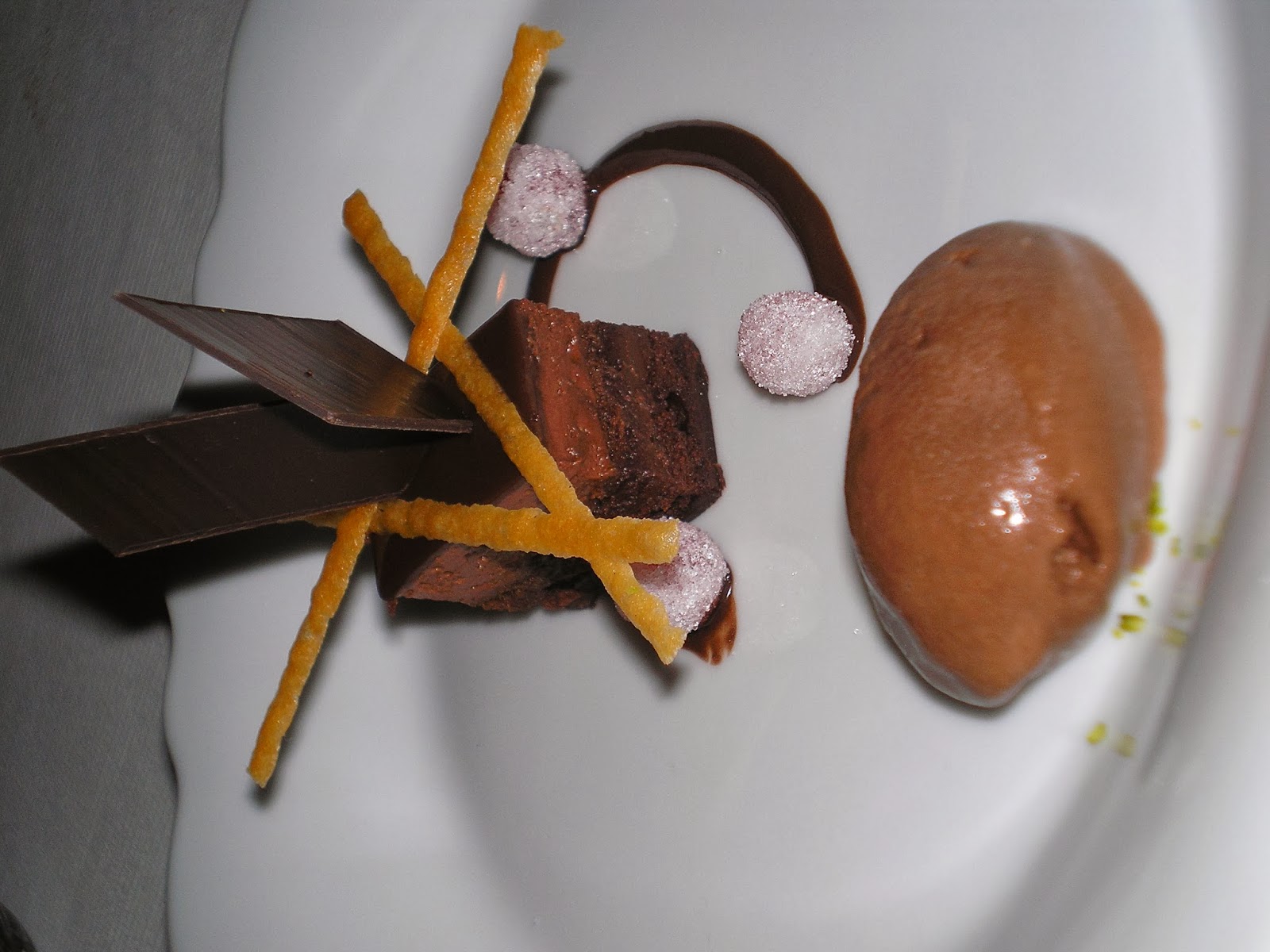Chef Pierre Gagnaire was the pioneer of nouveau French cuisine famous for his extraordinarily innovative and progressive food. I decided that I would choose his flagship restaurant “Pierre Gagnaire” for my 1st Michelin 3 star fine dining in Paris. The restaurant is located near by le Arc de Triomphe end of Champs-Élysées.
I had a lunch tasting menu which was smaller than dinner menu because I was under tight schedule to catch the trans-Atlantic flight home. The décor is modern in soft brown graduations with bold art works and beautiful floral arrangements in sync with the style of food served. Wine cellar is surrounded by glass walls situated in the middle of dining room.
It started with Amuse Bouche. I was too overwhelmed with the varieties of Amuse Bouche that I did not take sufficient notes while dining in the restaurant that I had difficulties to recollect all the details. There was a macaron with blackcurrant sandwiched in between white meringue. I barely remembered the foie gras pastry and the watermelon jelly. But, all of them were delicious. Chef Pierre Gagnaire, like Chef Joachim Wissler at Vendome, is a master of Amuse Bouche. I personally love Amuse Bouche and fully agreed with what Chef Jean-George Vongerichten said “The Amuse Bouche is the best way for a great chef to express his big ideas in small bites.”


Pierre Gagnaire’s services were attentive and impeccable. One service managers stood at a corner to monitor each guest’s comfort condition and walked around the whole space every five minutes to make sure each guest was well attended. It served wonderful varieties of house-baked bread. My favorite was seaweed bread, they were unbelievably tasty definitely much better than the one that I later had at Guy Savoy.


1st course – “Nettle’s jelly with chives, cauliflowers’ heads and souffléd bread.” This was the 1st time that I ever tasted nettle. My server tried his best to explain it to me what it tasted like and agreed to offer me a substitute if I did not like the taste. I somehow found out nettle’s green taste was a bit too strong.
2nd course – “Salpicon of tourteau, dog cockles and shredded celeriac in remoulade sauce flavored with curcuma.” Dog cockle, one type of shellfish, is edible and enjoyed in many European countries. The flesh has a reputation for becoming tough if overcooked. It has an apparently sweet and almond-like flavor. In this dish, dog cockle was tender and tasty, with shredded celeriac in remoulade sauce flavored with tumeric. Tumeric is in the curcuma family bearing a curry-like yellow color and has a milder taste and milder yellow tone than curry. This dish was well prepared and it was not traditional French cuisine.
3rd course – “Pig’s ear/haddock/small mackerel.” It was a rare combination of sliced meat and fillets of fish.
4th course - “Bouchot mussels mariniére with leeks.” Marinated mussels served with jullienned leeks. Mussels were fresh, plump and juicy.
5th course – “Bloody-Mary sorbet, velvety soup of ewe’s milk cheese.” This turned out to be my favorite course in this meal. It was a perfection of innovation, the alcohol was not too overwhelming and the cheesy flavor was just enough to enrich the taste.
2nd course substitute – I was offered sautéed fresh walnuts and chanterelle mushrooms from the Loire Valley. Loire Valley has thousands of natural caverns ideal for growing varieties of mushroom. It was a very simple but tasty dish.
6th course – “Octopus stew with Nyons olives, crispy jumbo shrimps wrapped in a veil of chickpeas’ flour.” I did not know where Chef Gagnaire got his shrimps. But, they were biggest that I have ever seen. In addition, they were tender and tasty. Octopus was stewed with other ingredients and tomato sauce, and shrimps were added before serving.
7th course – Aubergine cannelloni with craterellus mushrooms.” This dish was made with sliced eggplants. Each sliced eggplant was sautéed and stuffed with shredded mushrooms. The type of mushroom was different from the substitute course that I just had.
8th course – “Avocado scampi.” This dish was made of avocado and shrimp in tempura, served with black olive puree. This was a delicious fusion dish.
9th course – “Rump and caillette of veal roasted and infused in a broth of braised stuffed tiny artichokes; semi-preserved rates potatoes with meniguette.” The vegetables were cooked to the right texture and harmonious with veal. Nothing in the plate has been spared of any detailed attention.
Palate Cleaner – “Lime & Lemon mouse.” It had pungent citric taste and was very light. The sweet taste of lime and the sour taste of lemon made the fused flavor even more refreshing.
Desert: It was a galore!
10th course – Varieties of petit four with beautiful presentation.
11th course – Thin wafer with raspberry and fresh cream.
12th course – Poached pear in puff pastry with wine sauce.
13th course – Fig with orange cake and orange sauce.
14th course – Chocolate cake with chocolate ice cream.
Then, there were some chocolate truffles brought to the table. It was close to the departure time for the airport. In addition, my stomach has reached its limit after I consumed all the courses. I had to ask the manager to pack chocolate truffles in a box. Their staff was so observing and attentive that they noticed that I loved their seaweed breads. When I got home, I noticed they have packed 4 seaweed breads in the box.
Toward the end of meal, Chef Gagnaire came out to greet every guest in the dining room. I did not have much conversation, besides the simple phrases, with him because his English proficiency was as good as my French proficiency. However, I did notice he spent time with a few guests appeared to be the frequent diners. I agreed with them. I would like to come back to this restaurant in one of my future trips to Paris.



















































